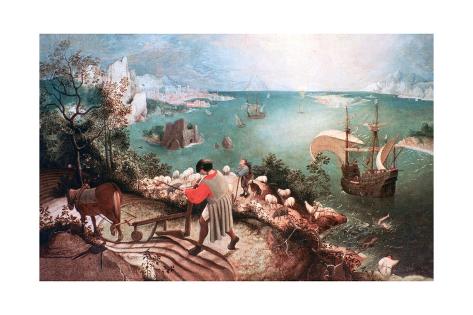

Manfred Sellink, for example, in his magnificent 2007 monograph “Bruegel: The Complete Paintings, Drawings and Prints,” reviews the history of the attribution question. The soon to be released publication, The Brueg(H)el phenomenon, from the Royal Institute for Cultural Heritage (KIK/IRPA) in Brussels, written by Christina Currie and Dominique Allart, puts forward evidence that the painting was painted near the year 1600, decades after Bruegel’s death.įor years scholars have been postulating that this work was not characteristic of Bruegel’s works in several key areas. Other details in the works are equally suspicious: the sun indicates the wrong time of the day, and the ship is rigged incorrectly.Big news in the Bruegel-sphere this week with new evidence that the famous “Landscape with the Fall of Icarus” is indeed not by Bruegel the Elder. Yet this version dates back only to 1577, still a handful of years too late to be a Bruegel creation. In 1935, a second version of the same landscape was found, with added details like the image of Daedalus flying above the shepherd. Studies on the artwork suggest that the piece may date to 1600, some thirty years after Bruegel’s death. Children drowning? Who cares, I’ve got fish to catch.īruegel’s masterpiece has recently been called into question- and not because of the callous disinterest of the farmers. Grisly death aside, the scene looks as tranquil as a Mary Cassatt painting. The image of a gentleman hurtling towards the sea with a half-melted pair of wings doesn’t even draw their eyes away from their work. The shepherd tends his sheep, the farmer works his land, and the fisherman casts his line. Bruegel chose to twist the story, instead depicting the villagers engrossed in their daily grind.

In the text, they believe the two men to be gods descending to earth. Pieter Bruegel drew inspiration from Ovid’s retelling of the myth, in which a shepherd and fisherman observe the flying pair. When the duo tried to fly to safety, Icarus drew too near to the sun and melted his wings, plummeting to his death in the sea. Eager to escape, Daedalus made wings out of wax and feathers. King Minos had imprisoned both father and son in his Labyrinth, and Daedalus feared what he knew would be the Ancient Greek equivalent of an unending family road trip. A better fate, to be sure, but what mastermind wants to go from inventing the compass to being a literal birdbrain?Įvery good Greek myth needs a gruesome end ( Diana and Actaeon springs to mind) and Daedalus’ son Icarus was doomed to die in the name of poetic justice. Divine intervention saved Talos from certain death- the goddess Pallas turned the unfortunate genius into a partridge. Jealous of his pupil’s inventions, which included the saw, Daedalus pushed his star student off a cliff.

When he took his nephew Talos on as an apprentice, the younger scholar proved a little too talented for Daedalus’s liking. Landscape with the Fall of Icarus has all the elements of an idyllic country landscape: the farmer ploughing, the sheep grazing, and the son of an inventor plunging to his death in the Mediterranean.ĭaedalus was a Greek inventor with skill to rival Leonardo’s.


 0 kommentar(er)
0 kommentar(er)
